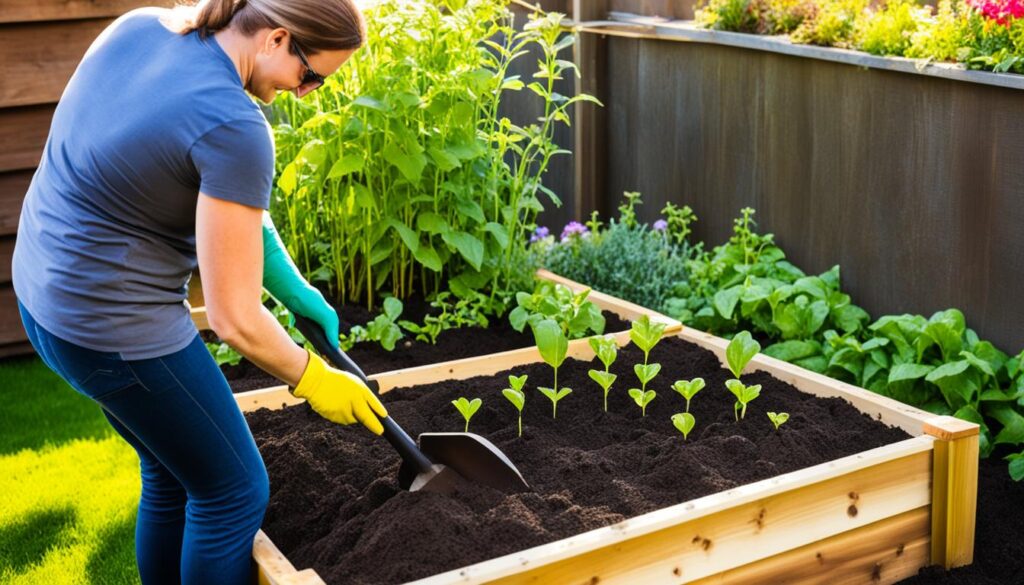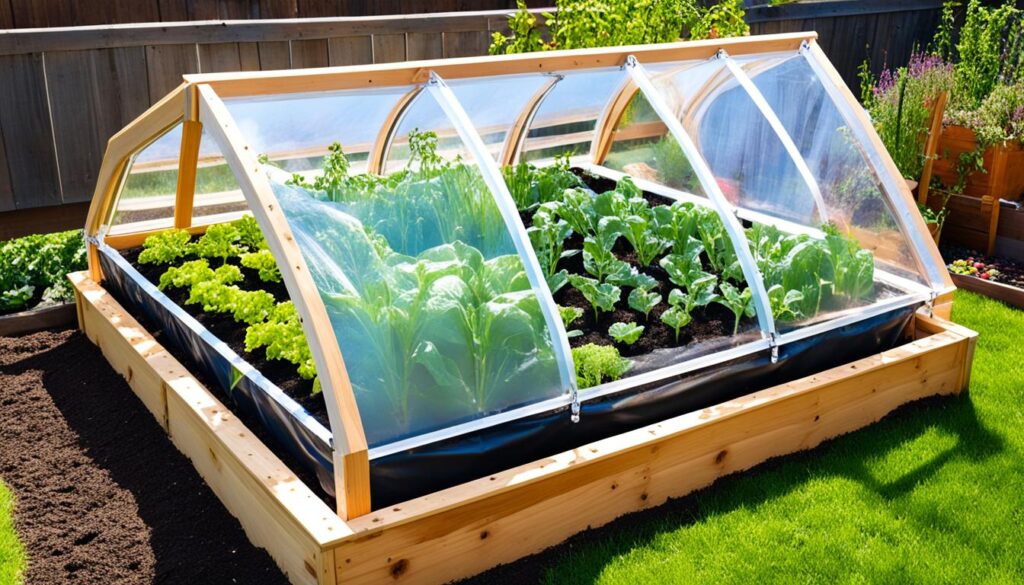Ferns are highly versatile plants that add a naturalistic and informal appearance to gardens. They come in various colours, shapes, and sizes and are low maintenance, pest-free, and long-lived. Ferns can be evergreen or deciduous, with the latter dying back in winter and regrowing in spring. The optimal time for fern growth is in spring, when the tightly rolled fiddleheads gradually unfurl into magnificent fronds.
Key Takeaways:
- Ferns add a naturalistic and informal appearance to gardens.
- Ferns can be evergreen or deciduous.
- The optimal time for fern growth is in spring.
- Deciduous ferns die back in winter and regrow in spring.
- Ferns come in various colours, shapes, and sizes.
Choosing the Right Fern for Your Garden
When it comes to selecting a fern for your garden, there are a few things to consider. First, think about the available space and the desired outcome. Ferns come in a wide variety of shapes and growth habits, making it important to choose one that fits well in your garden.
Some ferns, like Dryopteris Cristata, are small and reach a maximum height of 30cm, making them great options for smaller gardens or containers. On the other hand, ferns like Dicksonia Antarctica can grow up to an impressive 8 meters, creating a striking centerpiece in larger landscapes.
Another factor to consider is whether you prefer evergreen or deciduous ferns. Evergreen ferns provide winter interest and structural elements to the garden, while deciduous ferns offer the delight of new fronds unfurling in spring, creating fresh and seasonal effects.
If you’re looking to make a bold statement, tree ferns are an excellent choice. These majestic ferns can serve as stand-alone centerpieces, adding a touch of drama to any garden.
When planting ferns, keep in mind that they often look best when planted in groups. To create a natural and harmonious appearance, plant odd numbers of each fern variety. This arrangement will create balance and visual interest.
Types of Ferns and Their Growth Habits
| Fern Variety | Size | Evergreen/Deciduous | Growth Habit |
|---|---|---|---|
| Dryopteris Cristata | Small (up to 30cm) | Deciduous | Upright, delicate fronds |
| Dicksonia Antarctica | Tall (up to 8 meters) | Evergreen | Large, spreading fronds |
| Tree Ferns | Variable | Evergreen | Large fronds, trunk-like stem |
As you can see, there is a fern for every garden and personal preference. Take the time to research and choose the right ferns that will thrive in your garden’s specific conditions, and enjoy the beauty and elegance they bring to your outdoor space.
Where to Plant Ferns
Ferns are shade-loving plants and thrive in partial sun or dappled shade. They are ideal for adding lush greenery to areas with less sunlight. While evergreen ferns can tolerate more sunlight, deciduous ferns prefer a more shaded spot. You can create a beautiful mix of different fern varieties to add texture and depth to your garden.
One of the best locations for ferns is in areas where other plants struggle to thrive due to heavy shade. Ferns can bring life and vibrancy to these challenging areas, filling them with their lush foliage and delicate fronds. They can transform a dull and uninspiring spot into a captivating garden oasis.
“Ferns are nature’s way of bringing a touch of magic to shady corners of your garden.”
When it comes to soil, ferns are not very demanding. They can grow in any evenly moist, well-drained soil. Ferns generally prefer neutral to alkaline soil conditions. However, the Royal fern is an exception as it prefers a neutral to acidic soil. Ferns are adaptable plants that can even grow as marginal plants around ponds or streams, enhancing the natural beauty of these water features.
| Type of Fern | Best Sun Exposure | Ideal Soil |
|---|---|---|
| Evergreen Ferns | Partial Sun | Neutral to Alkaline |
| Deciduous Ferns | Shaded | Neutral to Alkaline |
| Royal Fern | Partial Sun to Shade | Neutral to Acidic |
| Osmunda Regalis | Partial Sun to Shade | Moist, Well-drained |
Ferns are versatile plants that can be grown in various locations within your garden. Their adaptability to different sun exposures and soil types makes them a great choice for both sunny and shady spots. Consider the specific requirements of each fern variety when deciding the best location and growing conditions for your ferns.

When to Plant Ferns
Planting ferns at the right time is crucial for their optimal growth and establishment. Whether you are planting ferns in containers or directly in the ground, timing plays a key role in ensuring their success.
Containerized Ferns: Ferns in containers can be planted throughout the year, as long as the ground is not frozen or waterlogged. This provides flexibility and convenience, allowing you to add ferns to your garden at any time.
Ferns in the Ground: While containerized ferns enjoy more flexibility, the best time to plant ferns in the ground is in spring or early autumn. These seasons offer ideal planting conditions for ferns to establish themselves and thrive.
In drier areas, autumn planting is particularly recommended. Planting ferns in early autumn allows their roots to establish over winter, making them better equipped to tolerate hot, dry weather the following year.
| Planting Method | Best Time to Plant Ferns |
|---|---|
| Containerized Ferns | Year-round (except when ground is frozen or waterlogged) |
| Ferns in the Ground | Spring or early autumn (autumn planting recommended in drier areas) |
By planting ferns at the optimal time, you can ensure their successful establishment and promote healthy growth. Whether you choose containers or ground planting, following the recommended planting periods will give your ferns the best start.
How to Plant Ferns
Planting ferns in your garden is a rewarding experience that adds beauty and natural charm. To ensure the successful establishment of your ferns, it’s important to follow proper planting techniques. Here’s a step-by-step guide on how to plant ferns:
- Dig a planting hole: Start by digging a hole that is twice as wide as the container and to the same depth. This will provide ample space for the roots to spread out.
- Prepare the soil: Break up any compacted soil at the bottom and around the hole. This will help promote easy root penetration and ensure the ferns have access to essential nutrients.
- Tease out the roots: If you’re planting a containerized fern, gently tease out the roots from the root ball. This will encourage the roots to grow outward and establish themselves in the surrounding soil.
- Plant at the correct level: Place the fern in the hole at the same level it was in the pot. This will help prevent the crown of the fern from rotting and ensure proper growth.
- Backfill with organic matter: Backfill the hole with a mixture of the excavated soil and organic matter such as compost or well-rotted manure. This will improve moisture retention and provide essential nutrients for the ferns.
- Firm down the soil: Gently firm down the soil around the fern, ensuring that it is secure and stable in the planting hole.
- Water thoroughly: After planting, water the fern thoroughly to settle the soil and ensure that the roots make good contact with the surrounding soil.
- Mulch for weed suppression: Apply a layer of bark chippings or mulch around the base of the fern to suppress weeds and preserve moisture in the soil.
By following these steps, you can create an optimal planting environment for your ferns, promoting healthy growth and vibrant foliage.

Garden Care for Ferns
Ferns require minimal care in the garden. By following a few simple practices, you can ensure that your ferns grow healthy and thrive in their environment.
Watering Ferns
Watering is an important aspect of fern care, especially during prolonged dry weather. To prevent rotting foliage, it’s best to water ferns directly at the roots. This allows the water to reach the plant’s base and penetrate the soil, providing moisture where it’s needed most. Remember to water slowly and deeply, ensuring that the soil is evenly moist.
Mulching Ferns
Mulching is beneficial for ferns in several ways. It helps suppress weed growth around the plants, retains moisture in the soil, and improves the overall nutrient content. Each year, apply a layer of well-rotted garden compost or leaves around the base of your ferns, making sure not to cover the crowns. This mulch will not only enhance the appearance of your garden but also provide a conducive environment for your ferns to thrive.
Feeding Ferns
In general, ferns do not require regular feeding, as they can derive their nutrition from the soil. However, a slow-release fertilizer can be applied sparingly in the spring to give them a boost. Choose a balanced fertilizer specifically formulated for ferns and follow the manufacturer’s instructions for application. Remember, moderation is key to prevent over-fertilization, which can harm the ferns.
Pruning Ferns
Pruning ferns is essential for maintaining their health and appearance. In late winter or early spring, take the time to remove any old and dead fronds from your ferns. This helps promote new growth and allows the plant to allocate its resources more effectively. To prune, simply cut away the fronds close to the base of the plant. Be careful not to damage any emerging fiddleheads or young fronds.
Lifting and Dividing Ferns
As ferns grow and mature, their fronds may become smaller and sparse. This is a natural part of their growth cycle. To rejuvenate your ferns and maintain their vigor, you can lift and divide them. This process involves carefully digging up the clustered ferns and separating them into smaller sections. Each section should have a healthy root system and a sufficient number of fronds. Replant the divided ferns in suitable locations, ensuring to provide adequate spacing for future growth.
By implementing these gardening practices, you can ensure that your ferns remain healthy and vibrant year after year.
Winter Protection for Ferns
Winter can be a challenging time for many plants, including ferns. While ferns planted in the ground generally have natural defenses to survive the cold, some species require extra care and protection. In this section, I will discuss the various methods you can use to safeguard your ferns from the frost and ensure their healthy growth in the coming spring.
Protecting Half-Hardy Tree Ferns
Half-hardy tree ferns are particularly vulnerable to cold temperatures and frost damage. To protect them during winter, it is essential to create a protective barrier around their crown and fronds.
Start by placing a generous layer of straw or horticultural fleece on top of the crown of the tree fern. This extra insulation helps to trap heat and prevent freezing temperatures from reaching the delicate crown.
Next, wrap the fronds and trunk of the tree fern with garden fleece. Secure the fleece tightly to prevent wind from blowing it off. This additional layer of protection acts as a shield against frost, shielding the tree fern from the cold temperatures.
This combination of straw or horticultural fleece on the crown and wrapping the fronds and trunk with garden fleece provides an effective defense against frost damage and ensures the survival of your half-hardy tree ferns.
Alternative Methods for Cold Gardens
In colder climates where temperatures drop significantly, it may be necessary to take additional measures to protect your ferns. One option is to lift the ferns from the ground and plant them in pots. This allows you to move the ferns indoors or to a sheltered area during the winter months.
When lifting the ferns, ensure you dig wide around the root ball to minimize damage to the roots. Place the ferns in pots with well-draining soil and provide them with the same growing conditions they require during the growing season, including light and moisture.
Alternatively, if you have limited space or prefer not to lift your ferns, you can create a makeshift greenhouse or cold frame around them. This can be done by erecting a structure using transparent plastic or glass and ensuring proper ventilation to prevent rot and disease.
Preventing Winter Heaving of Deciduous Ferns
Deciduous ferns, on the other hand, do not typically require winter protection. However, during severe frosts, it is advisable to cover them with a layer of hay or straw. This will help insulate the ferns and prevent the ground from freezing and heaving, which can cause damage to the roots.
By taking steps to protect your ferns during the winter months, you can ensure their health and vitality for the upcoming growing season.
| Fern Type | Winter Protection |
|---|---|
| Half-hardy tree ferns | – Place straw or horticultural fleece on the crown – Wrap the fronds and trunk with garden fleece |
| Deciduous ferns | – Cover with hay or straw during severe frosts |
Ferns as Houseplants
Ferns are not only beautiful additions to gardens, but they can also thrive as houseplants, bringing a touch of nature indoors. With their delicate fronds and lush green foliage, they create a refreshing and calming atmosphere in any room. Here are some tips for growing ferns indoors, including the best ferns for indoor growth and how to care for them.
Popular Indoor Ferns
There are several fern varieties that are well-suited for indoor growth. Some popular choices include:
- Asplenium nidus: Also known as the Bird’s Nest Fern, this fern has beautiful, broad fronds resembling a bird’s nest. It thrives in bright, indirect light and moderate humidity.
- Adiantum monocolor: The Black Maiden Hair Fern features delicate, black stems and small, feathery fronds. It prefers bright, indirect light and high humidity.
- Blechnum gibbum: Known as the Silver Lady Fern, this compact fern has striking silver-green fronds. It does well in medium light and moderate humidity.
Caring for Indoor Ferns
Proper care is essential for the health and growth of indoor ferns. Consider the following tips:
- Lighting: Place your ferns in a spot with bright, indirect light. Avoid direct sunlight as it can scorch the delicate fronds.
- Soil and Watering: Plant your ferns in well-drained, moist soil. Ensure that the soil is evenly moist but not waterlogged. Water when the top inch of soil feels dry.
- Humidity: Ferns thrive in humid environments. Increase humidity by misting the fronds regularly or placing the pots on a tray filled with water and pebbles.
- Temperature: Keep indoor ferns away from drying radiators or open fires. They prefer temperatures between 60°F to 75°F (15°C to 24°C).
Tip: To create a more humid microclimate for your ferns, group them together or place them near other houseplants.
During the winter dormancy period, indoor ferns do not require fertilization. However, when spring arrives, you can feed them with a balanced houseplant fertilizer diluted to half strength. Always follow the manufacturer’s instructions for application.
With proper care and attention, ferns can thrive indoors, adding a touch of natural beauty to your home. They bring a sense of tranquillity and freshness while purifying the air. So why not invite these beautiful, leafy companions into your indoor space?
Propagating Ferns
Ferns offer a unique and beautiful addition to any garden or indoor space. While they may not produce flowers or seeds, propagating ferns can be an exciting and rewarding process. There are two popular methods for propagating ferns: from spores and from bulbils.
Propagating Ferns from Spores
Propagating ferns from spores is a specialized method that requires patience and attention to detail. Spores are tiny reproductive structures that develop on the underside of fern fronds. To propagate ferns from spores, follow these steps:
- Collect mature fronds with spores. Look for fronds with ripe, brownish spore capsules.
- Place the fronds in a paper bag and allow them to dry for a few days. This will help release the spores.
- Prepare a sterile growing medium, such as a mixture of peat moss and perlite.
- Sprinkle the spores evenly over the surface of the growing medium.
- Cover the tray or pot with a clear plastic bag to create a humid environment.
- Place the tray or pot in a warm and bright location, but away from direct sunlight.
- Keep the growing medium damp by misting it regularly.
- After several weeks to months, tiny green heart-shaped gametophytes will appear. These are the young ferns.
- Wait until the young ferns develop into small plants with fronds, then carefully transplant them into individual pots.
Propagating ferns from spores requires close attention to humidity, temperature, and sterile conditions. It can take up to two years for the ferns to reach a suitable size for planting in the garden.
Propagating Ferns from Bulbils
Some fern species, such as Asplenium bulbiferum, produce bulbils that can be used for propagation. Bulbils are small, bulb-like structures that form on the fronds of the fern. To propagate ferns from bulbils, follow these steps:
- Identify fronds with bulbils. These are usually larger fronds with small bulb-like structures along the leaflets.
- Carefully remove the frond with the bulbils from the parent plant.
- Fill a pot with seed compost or a well-draining potting mix.
- Place the frond on the surface of the compost, with the bulbils in contact with the soil.
- Gently press the frond into the compost to ensure good soil contact.
- Cover the pot with a clear plastic bag to create a humid environment.
- Keep the soil evenly moist and provide indirect light.
- After several weeks, the bulbils will develop roots.
- Once the bulbils have rooted, carefully separate them from the frond and transplant them into individual pots.
When propagating ferns from bulbils, it’s important to keep the soil consistently moist and provide the young ferns with a suitable environment for root development.
By propagating ferns from spores or bulbils, you can expand your collection of these beautiful plants and share them with others. Whether you choose the intricate process of growing ferns from spores or the convenience of propagating from bulbils, the journey of nurturing new ferns is a rewarding experience.
Troubleshooting and Problem-solving for Ferns
When it comes to caring for ferns, you’ll be pleased to know that they are generally trouble-free and resistant to pests and diseases. However, there are a few common issues you may encounter while growing these beautiful plants.
If you notice slug attacks on your ferns, don’t fret! You can easily address this problem by placing broken eggshells around the base of the plants or using slug killer pellets. This will help deter the slugs and protect your ferns from their leaf-chomping activity.
Remember that different fern varieties have specific growing requirements, such as sunlight exposure, soil type, and moisture levels. Some popular fern species include Osmunda regalis, Asplenium nidus, Asplenium scolopendrium, Adiantum aleuticum ‘Imbricatum’, Blechnum spicant, Matteuccia struthiopteris, and Dicksonia antarctica. Therefore, it’s crucial to understand the needs of each fern you plan to grow to ensure their optimal health and growth.
By addressing these common issues and being attentive to the specific requirements of your ferns, you’ll enjoy a lush and thriving fern garden that adds a touch of natural beauty to your outdoor space.









